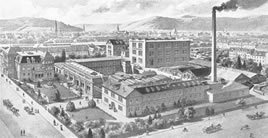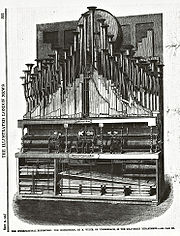|
| |
A Short History of the Welte Company

This photos shows the Welte factory in Frieburg
Germany
in the early part of the 1900 Century
|
Back |
| |
M. Welte & Sons, Freiburg and New York was a manufacturer
of orchestrions,
organs
and reproducing
pianos.
From 1832 until 1932, the firm produced mechanical musical Instruments
of the highest quality. The firm's founder, Michael Welte (1807-1880),
and his company were prominent in the technical development and construction
of orchestrions from 1850, until the early 20th century.
Illustration: 1862 International Exhibition London: The Orchestrion by M. Welte,
of Vöhrenbach,
In the Zollverein
Department.
The
Illustrated London News, Sept. 20, 1862 |
 |
| |
In 1872, the firm moved from the remote black forest town of Vöhrenbach, into a newly developed business complex beneath the main railway-station in Freiburg, Germany. They created an epoch-making development when they substituted the playing gear of their instruments from fragile wood pinned cylinders to perforated paper rolls. In 1883, Emil Welte (1841-1923), the eldest son of Michael, who had emigrated to the United States in 1865, patented the paper roll method (US-Patent 87.599). In 1889, the technique was further perfected, and again protected through patents. Later, Welte built only instruments using the new technique, which was also licensed to other companies. With branches in New York and Moscow,
and representatives throughout the world, Welte became very well known. |
|
 |
The firm was already famous for its inventions in the field of the reproduction of music when Welte introduced the Welte-Mignon reproducing piano in 1904, which came onto the market in 1905. As a result of this invention by Edwin Welte (1876-1958) and his brother-in-law Karl Bockisch (1874-1952), one could now record and reproduce the music played by a pianist as true to life as was technologically possible at the time.
Illustration: One of the first Welte-Mignon-Pianos, keyboardless, built 1905-ca. 1908 |
|
| |
Welte Inc.
In 1912 a new company was founded, the "M. Welte & Sons. Inc." in New York, and a new factory was built in Poughkeepsie, New York. Shareholders were predominantly family members in the U.S. and Germany, among them Barney Dreyfuss, Edwins brother-in-law.
As a result of the Alien Property Custodian enactment, during the First World War, the company lost their American branch and all of their U.S. patents. This caused the company great economic hardship. Later the depression and the mass production of new technologies like the radio and the electric record player in the 1920s virtually brought about the demise of the firm and its expensive instruments. Other companies with similar products like American Piano Company (Ampico) and Duo-Art
also began to fade from the scene at this time.
|
|

Welte & Sons, Pougkeepsie factory building 1913/14. Today: Central Hudson Gas & Electric Corporation
|
| |
From 1919 on, Welte built also theatre organs. With the introduction of "talkies" around 1927, this need began to also diminish and by 1931 production of these instruments was severely curtailed. The last big theatre organ was a custom built instrument for the Norddeutscher Rundfunk (NDR, North German Broadcasting) studio in Hamburg, still in place and still playing. Some other theatre organs of Welte are today in museums.
In 1932 the firm, now with Karl Bockisch as sole owner, barely escaped bankruptcy, and began to concentrate on the production of church organs and other specialty organs.
The last project of Edwin Welte was an electronic organ equipped with photo-cells, the Lichttonorgel or Phototone-Organ. This instrument was the first ever which used analog sampled sound. In 1936, a prototype of this type of organ was demonstrated at a concert in the Berliner Philharmonie. The production of these organs - in cooperation with the
Telefunken Company - was halted by the Nazi-government because the inventor, Edwin Welte, was married to Betty Dreyfuss, who was Jewish.
The business complex in Freiburg was bombed and completely destroyed in November 1944. This event seemed to obliterate the closely kept secrets of the firm and their recording apparatus and recording process appeared lost forever. But in recent years parts of the recording apparatus for the Welte Philharmonic-Organs and documents were found in the United States. It was then possible to theoretically reconstruct the recording process. The Augustinermuseum of Freiburg keeps the legacy of the company - all that survived the Second World War.
|
|
|
|

